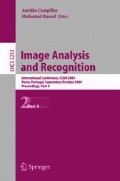Abstract
We propose a simple method for tracking a nonparameterized subject contour in a single video stream with a moving camera and changing background. Our method is based on level-of-detail (LOD) Canny edge maps and graph-based routing operations on the LOD maps. LOD Canny edge maps are generated by changing scale parameters for a given image. Simple (strong) Canny edge map has the smallest number of edge pixels while the most detailed Canny edge map, Wcanny N , has the biggest number of edge pixels. We start our basic tracking using strong Canny edges generated from large image intensity gradients of an input image, called Scanny edges to reduce side-effects because of irrelevant edges. Starting from Scanny edges, we get more edge pixels ranging from simple Canny edge maps until the most detailed Canny edge maps. LOD Canny edge pixels become nodes in routing, and LOD values of adjacent edge pixels determine routing costs between the nodes. We find a best route to follow Canny edge pixels favoring stronger Canny edge pixels. Our accurate tracking is based on reducing effects from irrelevant edges by selecting the stronger edge pixels, thereby relying on the current frame edge pixel as much as possible contrary to other approaches of always combining the previous contour. Our experimental results show that this tracking approach is robust enough to handle a complex-textured scene.
Access this chapter
Tax calculation will be finalised at checkout
Purchases are for personal use only
Preview
Unable to display preview. Download preview PDF.
References
Paragios, N., Deriche, R.: Geodesic active contours and level sets for the detection and tracking of moving objects. IEEE Trans. on Pattern Analysis and Machine Intelligence 22, 266–280 (2000)
Nguyen, H.T., Worring, M., van den Boomgaard, R., Smeulders, A.W.M.: Tracking nonparameterized object contours in video. IEEE Trans. on Image Processing 11, 1081–1091 (2002)
Roerdink, J.B.T.M., Meijster, A.: The watershed transform: Definition, algorithms and parallelization strategies. Fundamenta Informaticae 41, 187–228 (2000)
Nguyen, H.T., Worring, M., van den Boomgaard, R.: Watersnakes: energy-driven watershed segmentation. IEEE Trans. on Pattern Analysis and Machine Intelligence 25, 330–342 (2003)
Kass, M., Witkin, A., Terzopoulos, D.: Snakes: Active contour models. International Journal of Computer Vision 1, 321–331 (1987)
Peterfreund, N.: Robust tracking of position and velocity with kalman snakes. IEEE Trans. on Pattern Analysis and Machine Intelligence 21, 564–569 (1999)
Fu, Y., Erdem, A.T., Tekalp, A.M.: Tracking visible boundary of objects using occlusion adaptive motion snake. IEEE Trans. on Image Processing 9, 2051–2060 (2000)
Author information
Authors and Affiliations
Editor information
Editors and Affiliations
Rights and permissions
Copyright information
© 2004 Springer-Verlag Berlin Heidelberg
About this paper
Cite this paper
Park, J., Kim, TY., Park, S. (2004). LOD Canny Edge Based Boundary Edge Selection for Human Body Tracking. In: Campilho, A., Kamel, M. (eds) Image Analysis and Recognition. ICIAR 2004. Lecture Notes in Computer Science, vol 3212. Springer, Berlin, Heidelberg. https://doi.org/10.1007/978-3-540-30126-4_65
Download citation
DOI: https://doi.org/10.1007/978-3-540-30126-4_65
Publisher Name: Springer, Berlin, Heidelberg
Print ISBN: 978-3-540-23240-7
Online ISBN: 978-3-540-30126-4
eBook Packages: Springer Book Archive

